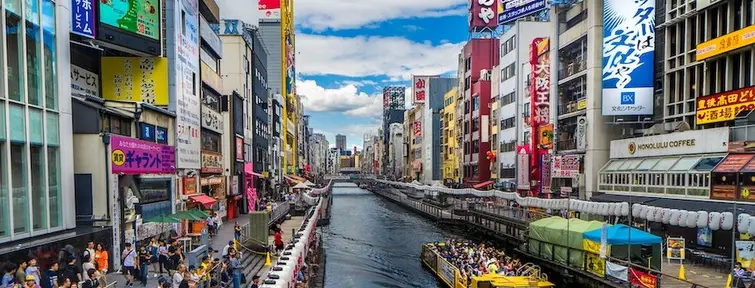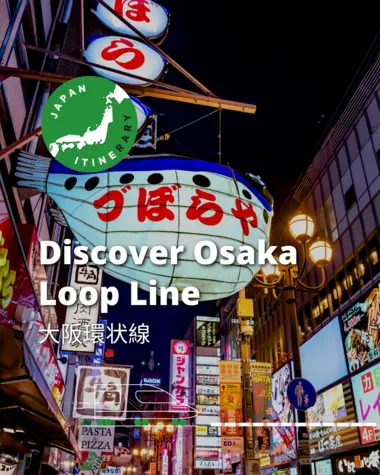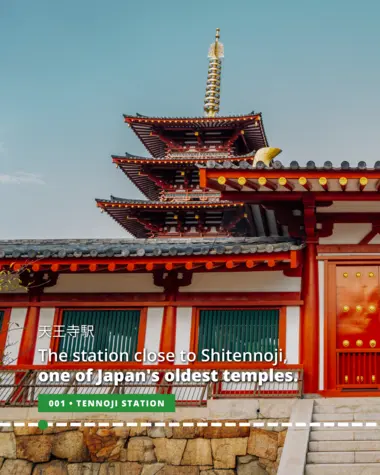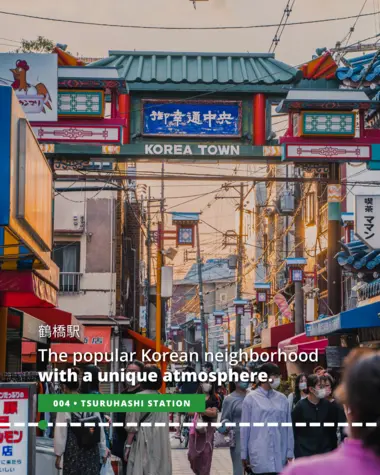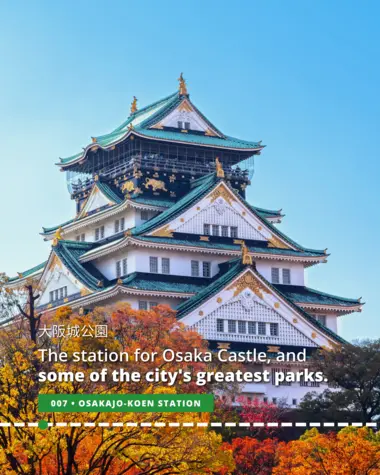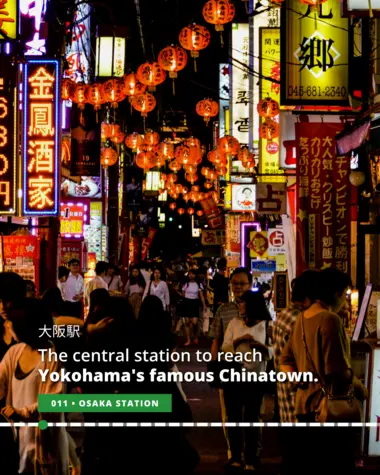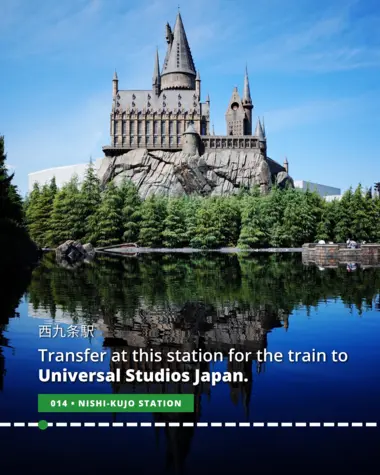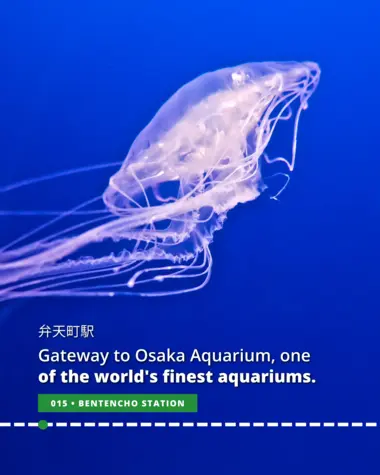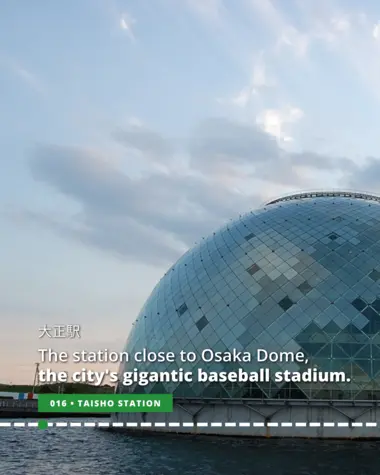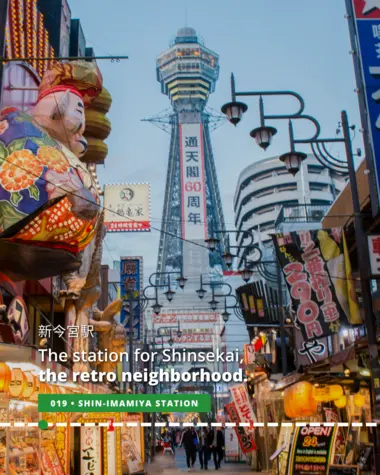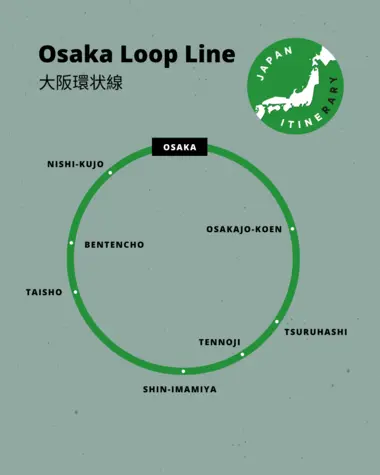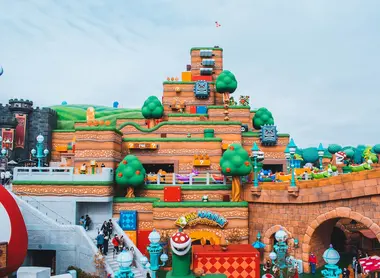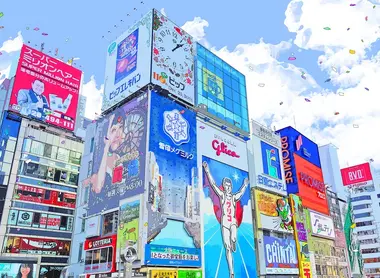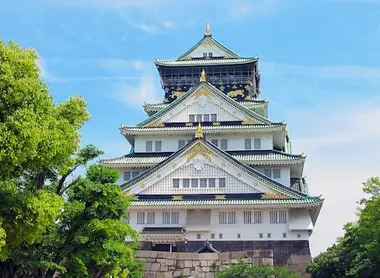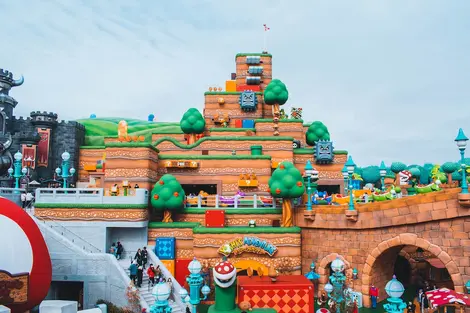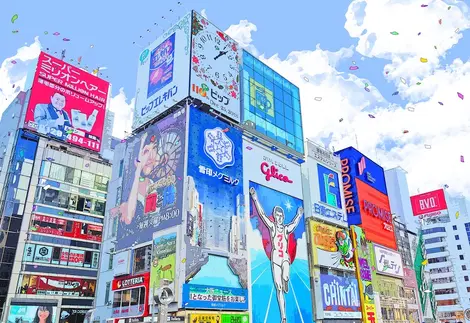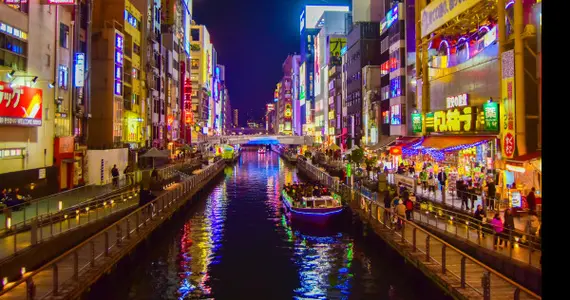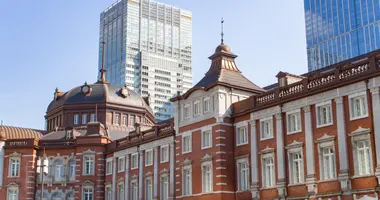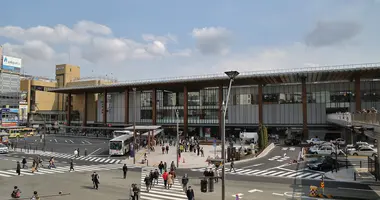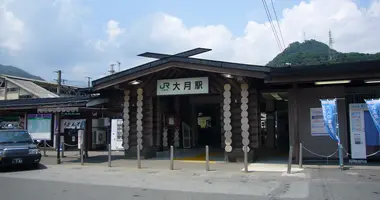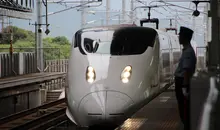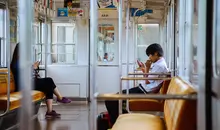Osaka Loop Line: Your Guide to Efficient Travel in Osaka
- Published on : 22/03/2025
- by : Japan Experience
- Youtube
The Osaka Loop Line (大阪環状線, Ōsaka kanjō-sen) is one of the most convenient train lines that runs through metropolitan Osaka, operated by West Japan Railway Company (JR West). This distinctive circular railway encircles central Osaka, carrying over 984,000 passengers daily. With a total track length of 21.7 km and 19 stations, the Loop Line offers quick and easy access to major attractions including Osaka Station, Osaka Castle, Korean Town (Tsuruhashi), and Tennoji. As a vital transportation artery, it connects seamlessly with numerous other rail services, making it an essential part of any Osaka travel itinerary.
What is the Osaka Loop Line?
The Osaka Loop Line is a circular railway system that forms a complete loop around central Osaka. Unlike most train lines in Japan that use the "up" (上り, Nobori) and "down" (下り, Kudari) directional convention, the Loop Line uses "outer loop" (外回り, Soto mawari) for clockwise trains and "inner loop" (内回り, Uchi mawari) for counterclockwise trains, similar to Tokyo's Yamanote Line.
There are two tracks around the heart of metropolitan Osaka, with trains operating in both directions. The Loop Line consists of distinctive orange trains with white JR graphics on the front, rear, and sides. The train schedule varies, but typically two trains depart from Tennōji Station and Ōsaka Station every five minutes in opposite directions.
Fully circling the loop takes approximately 40 minutes, allowing passengers to admire Osaka's diverse scenery. Traffic is generally heavier in the eastern half (Osaka–Kyōbashi–Tennōji) than in the western half via Nishi-Kujō, reflecting the population density and commercial activity in these areas.
While not as central to Osaka's transportation as the Yamanote Line is to Tokyo (the Osaka Metro Midosuji Line serves that function), the Loop Line is nonetheless crucial for efficient travel around the city and connects seamlessly with other JR lines and private railways.
The Complete Loop Line Route: All 19 Stations Explained
Traveling counterclockwise from Osaka Station (0 KM), here's a comprehensive guide to all 19 stations on the Osaka Loop Line:
1. Osaka Station (大阪駅)
The starting point of the Loop Line and Osaka's main transportation hub. This recently renovated station connects to the Tokaido Main Line, JR Kyoto Line, JR Kobe Line, JR Takarazuka Line, Osaka Higashi Line, and JR Tozai Line. The surrounding "Osaka Station City" features shopping malls like LUCUA and Daimaru Umeda, plus numerous restaurants and attractions.
2. Fukushima Station (福島駅)
Just one stop from Osaka Station, Fukushima is surrounded by excellent dining options. The area below the elevated tracks houses numerous bars, wine taverns, and sushi restaurants. North of the station is the bustling Fukushima Shoten-dori Shopping Street. Connection available to the JR Tozai Line.
3. Noda Station (野田駅)
A relatively quieter station primarily serving local residents. Note that direct Yamatoji and Hanwa Line trains bypass this station.
4. Nishikujo Station (西九条駅)
An important transfer point to the JR Yumesaki (Sakurajima) Line that leads to Universal Studios Japan. Take this transfer if you plan to visit USJ, which is just a 5-minute ride away. The park, opened in March 2001, spans 39 hectares and is the most visited amusement park in Japan after Tokyo Disney Resort.
5. Bentencho Station (弁天町駅)
Gateway to Osaka Aquarium (Kaiyukan), one of the world's finest aquariums, and the Tempozan Giant Ferris Wheel. Both attractions can be reached in about 10 minutes on foot or via a short bus ride.
6. Taisho Station (大正駅)
A 7-minute walk from this station leads to Osaka Dome (now Kyocera Dome), the city's baseball stadium and home field of the Orix Buffaloes team.
7. Ashiharabashi Station (芦原橋駅)
A small local station. Like Noda, rapid trains typically bypass this station.
8. Imamiya Station (今宮駅)
Connects to the Kansai Main Line. Another station frequently skipped by rapid services.
9. Shin-Imamiya Station (新今宮駅)
Shinsekai's nostalgic atmosphere makes it a must-see district. The famous Tsutenkaku Tower, built in 1912 and inspired by the Eiffel Tower, is located here. This area is the best place to try kushikatsu, one of Osaka's specialties consisting of various skewered and deep-fried foods. Connection available to the Kansai Main Line.
10. Tennoji Station (天王寺駅)
A major transportation hub in southern Osaka connecting to the JR Kansai Main Line (Yamatoji Line) and JR Hanwa Line. Nearby attractions include Shitennoji Temple (one of Japan's oldest temples, a 10-minute walk north) and the Abeno Harukas building (Japan's tallest skyscraper at 300 meters).
11. Teradacho Station (寺田町駅)
A local station serving primarily residential areas.
12. Momodani Station (桃谷駅)
Another primarily residential station with local amenities.
13. Tsuruhashi Station (鶴橋駅)
Famous for the Korean district (Koreatown) with its bustling market and authentic Korean restaurants. The unique atmosphere comes from its close connection with Korea, evident in the international market and numerous Korean food stalls. Adjacent to Tsuruhashi is Uehommachi, a historic district and major transport hub for Iseshima and Nara.
14. Tamatsukuri Station (玉造駅)
A station serving local residents and businesses.
15. Morinomiya Station (森ノ宮駅)
The closest station to the eastern side of Osaka Castle Park. This station also serves as a depot for the Loop Line trains.
16. Osakajo-Koen Station (大阪城公園駅)
The primary station for Osaka Castle, one of Japan's most famous historical landmarks. The castle park covers about two square kilometers and features grassy areas, sports facilities, and a shrine. It's also one of Osaka's most popular cherry blossom viewing spots in spring, particularly the Nishinimaru Garden with over 600 cherry trees.
17. Kyobashi Station (京橋駅)
A major transfer point connecting to the Katamachi Line and JR Tozai Line. The surrounding area is a commercial center with numerous shops and restaurants.
18. Sakuranomiya Station (桜ノ宮駅)
Known for beautiful cherry blossom viewing along the Okawa River in spring. The riverside promenade makes for a pleasant walk.
19. Temma Station (天満駅)
Near the entrance to Tenjinbashisuji Shopping Street, a 2.6-kilometer covered shopping arcade featuring approximately 800 shops. The nearby Osaka Tenmangu Shrine is famous for its Tenjin Matsuri festival held on July 24 and 25, one of Osaka's three major festivals.
Types of Trains and Services on the Osaka Loop Line
JR West operates several types of trains on the Osaka Loop Line to accommodate different travel needs:
Local Trains (普通, Futsū)
Local trains operate all day and make stops at every station. Some operate over the complete loop, while others serve only the eastern half between Osaka and Tennōji via Kyōbashi. These trains are identified by their distinctive orange color with white JR graphics. Eight-car EMUs of the 323 series are primarily used, with the 221 series, 223 series, and 225 series used during morning rush hours.
Sakurajima Line Trains (JR Yumesaki Line)
Trains of the Sakurajima Line (also called JR Yumesaki Line) operate through to the Loop Line to/from Kyōbashi and Tennoji. These services are vital for visitors heading to Universal Studios Japan, which can be accessed from Universal City Station on this line. Eight-car 323 series EMUs are typically used for these services.
Yamatoji Rapid Services (大和路快速, Yamatoji Kaisoku)
These trains began operating in 1973 and originate at Tennōji on the loop. They travel "inner" via Osaka, and after stopping at Tennōji after a complete circuit, exit onto the Kansai Main Line (Yamatoji Line) toward destinations like Kamo, Nara, or Ōji. While on the loop, these trains skip certain stations. Usually 8-car and 4+4 car 221 series EMUs are used.
Regional Rapid Services (区間快速, Kukan Kaisoku)
Similar to Yamatoji Rapid services but stop at all stations on the loop. These trains continue to the Kansai Main Line after completing their loop circuit.
Kansai Airport Rapid Services (関空快速, Kankū Kaisoku)
These trains provide direct access to Kansai International Airport from the Loop Line. They typically originate at either Tennoji or Kyobashi, operate on the inner loop via Osaka, pause at Tennoji, and then exit from the loop to the Hanwa Line. This service pattern increased significantly after Kansai Airport opened in 1994. Eight-car 223 series and 225 series EMUs are used.
Kishūji Rapid Services (紀州路快速, Kishūji Kaisoku)
Similar to the Kansai Airport Rapid but bound for Wakayama via the Hanwa Line.
Limited Express Services
Premium Limited Express services such as Haruka (for Kansai International Airport) and Kuroshio (heading to southern Wakayama Prefecture) utilize the Osaka Loop Line to bypass the Tōkaidō Main Line and reach the Hanwa Line. On the loop, these trains typically stop only at Tennōji and occasionally at Nishi-Kujō.
The Limited Express trains use specialized rolling stock: 281 series and 271 series EMUs for Haruka services, and 283 series, 287 series, and 289 series EMUs for Kuroshio services.
Fares, Tickets, and Using the Japan Rail Pass
A special discount rate applies for travel within the Osaka Loop Zone (大阪環状線内, Ōsaka Kanjōsen-nai), which includes the Osaka Loop Line, the Sakurajima Line, and the segment between JR Namba Station and Tennōji Station of the Kansai Main Line.
Fares for Single Rides (Adult)
- 1-3 km: 120 yen
- 4-6 km: 160 yen
- 7-10 km: 170 yen
- 11-15 km: 190 yen
- 16-20 km: 260 yen
For travel between a station within the zone and a station outside the zone, or between two stations outside the zone, fares are calculated using a universal fare table, and the discount rate isn't applicable.
Using the Japan Rail Pass
The Japan Rail Pass fully covers the entire Osaka Loop Line and all JR lines branching off it, making it an excellent value for exploring Osaka. Pass holders can freely board any JR train on the Loop Line, including local trains and rapid services. However, for Limited Express trains like Haruka or Kuroshio, seat reservations may be required, though there's no additional charge with the pass.
Even if you're primarily staying in Osaka, using the Loop Line with your JR Pass can be highly cost-effective, especially when combined with trips to nearby cities like Hiroshima, Fukuoka, and Tokyo.
Tickets for Kansai Airport Access
While the Loop Line itself doesn't run directly to Kansai Airport, different stations along the line have trains running to the airport, including the JR Kansai Airport Rapid Service and Haruka Express. Key stations with airport services include:
- Tennoji Station
- Osaka Station
- Kyobashi Station
Connections to Other Lines and Key Destinations
The Osaka Loop Line serves as a connector between various railway lines, making it easy to reach major attractions both within and outside Osaka:
Major JR Line Connections
- JR Yumesaki (Sakurajima) Line - Access to Universal Studios Japan via Nishikujo Station
- JR Kansai Main Line (Yamatoji Line) - Connects to Nara from Tennoji Station
- JR Hanwa Line - Access to Kansai Airport and Wakayama from Tennoji Station
- JR Tozai Line - Connects at Kyobashi and Fukushima stations
- Tokaido Main Line (JR Kyoto Line, JR Kobe Line, JR Takarazuka Line) - Connect at Osaka Station
Key Destinations Near Loop Line Stations
Shopping and Entertainment Districts:
- Umeda/Kita Area (Osaka Station) - Major shopping malls, restaurants, and entertainment venues
- Namba/Minami Area (accessible via Tennoji) - Dotonbori, Shinsaibashi, entertainment districts
- Tenjinbashisuji Shopping Street (Temma Station) - 2.6km covered shopping street with approximately 800 shops
- Korean Town (Tsuruhashi Station) - Authentic Korean food and international market
Cultural and Historical Sites:
- Osaka Castle (Osakajo-Koen Station) - Historic castle and expansive park
- Shitennoji Temple (near Tennoji Station) - One of Japan's oldest temples
- Osaka Tenmangu Shrine (near Temma Station) - Important shrine and site of Tenjin Matsuri festival
- Shinsekai and Tsutenkaku Tower (Shin-Imamiya Station) - Retro district with distinctive tower
Family Attractions:
- Universal Studios Japan (transfer at Nishikujo to JR Yumesaki Line) - Major theme park
- Osaka Aquarium Kaiyukan (near Bentencho Station) - World-class aquarium
- Kyocera Dome (near Taisho Station) - Baseball stadium and concert venue
- Tempozan Giant Ferris Wheel (near Bentencho Station) - One of the world's largest Ferris wheels
Day Trip Destinations from the Loop Line:
- Kyoto - Via JR Kyoto Line from Osaka Station
- Kobe - Via JR Kobe Line from Osaka Station
- Nara - Via Yamatoji Line from Tennoji Station
- Kansai Airport - Via Hanwa Line from Tennoji Station
Tips for Navigating the Osaka Loop Line Like a Local
To make the most of your travels on the Osaka Loop Line, consider these practical tips:
Understanding Train Types
Not all trains on the Loop Line just go around in circles. About half the trains connect directly to other lines like the Yumesaki Line, Hanwa Line, and Yamatoji Line. To avoid ending up in suburban areas or even Kansai Airport unexpectedly, pay attention to:
- Train exterior - Orange-banded trains run only on the Loop Line or connect to the Yumesaki Line. White trains are Yamatoji Rapid services, while silver with blue bands are Hanwa Line services.
- Platform signs and electronic displays indicate the train's destination.
- In-vehicle announcements - Local Loop-only trains have automatic announcements at all stations, while direct services to other lines often have live conductor announcements.
Choosing Direction and Efficiency
Since trains travel in both directions (inner and outer loop), confirm which is faster for your destination:
- From Osaka Station to Tennoji, the inner loop (counterclockwise) is slightly faster.
- From Osaka Station to Osakajo-Koen (for Osaka Castle), the outer loop (clockwise) is faster.
- If you miss your stop, it may be faster to continue around the loop rather than getting off and changing direction.
Rush Hour Considerations
- Avoid rush hours (7:30-9:00 AM and 5:00-7:00 PM on weekdays) if possible, especially on the eastern section.
- Trains can be extremely crowded during these times, particularly between Osaka and Kyobashi.
- Additional rapid trains operate during morning rush hours but may not stop at all stations.
Station Navigation
- Many Loop Line stations have multiple exits leading to different areas.
- Large stations like Osaka and Tennoji can be confusing - follow signs carefully and don't hesitate to ask station staff for directions.
- The "North Gate" and "South Gate" at Osaka Station lead to different shopping and commercial areas.
Practical Information
- Women-only cars are available on some trains during morning rush hours.
- Free WiFi is available at major stations like Osaka and Tennoji.
- IC cards like ICOCA, Suica, or PASMO can be used instead of paper tickets for convenience.
- Familiarize yourself with the Loop Line before travel to get an idea of where everything is located in Osaka, making orientation easier.
- Consider trying the "Kanjo" challenge - a play on words with the Japanese pronunciation of "loop line" (Kanjo-sen), where enthusiasts aim to ride the entire line without stopping.
Accommodation Recommendations Near Loop Line Stations
- Hotel Ichiei - Located in Namba, a 3-minute walk from Namba Subway Station. Spacious rooms with Japanese tatami mats. www.hotel-ichiei.com/english
- Hotel Monterey Grasmere Osaka - One minute walk from JR Namba Station, convenient for direct access to the airport. https://www.hotelmonterey.co.jp/en/grasmere_osaka/
- Cross Hotel Osaka - A quiet, modern hotel located just a five-minute walk from the Dotonbori district and JR Namba Station. www.crosshotel.com/eng_osaka
Restaurant Recommendations Near Loop Line Stations
- Boteju - Famous for excellent okonomiyaki near Dotonbori. www.botejyu.com/botejyu/shop/osaka_souhonten.html
- Shabu-Tei - A shabu shabu restaurant near Osaka Station with a delicious "secret recipe" sauce. www.shabutei.co.jp/en
History and Development of the Osaka Loop Line
The Osaka Loop Line has a rich history spanning over 120 years, formed from the integration of four distinct segments:
Early Development (1889-1900)
The eastern half of the present Loop Line (Ōsaka to Tennōji via Kyōbashi) was originally called the Jōtō Line (城東線) and was opened by the Osaka Railway in 1895. This company also built the present Minami Osaka Line network. The line opened in two stages: Tennōji to Tamatsukuri on May 28, 1895, and Tamatsukuri to Umeda (present-day Osaka Station) on October 17, 1895.
Even earlier, in 1889, the company had opened its main line from Kashiwara to Tennōji and Minatomachi (present JR Namba), which included a short section of what would become the Loop Line between Tennōji and Imamiya. Imamiya Station itself opened in 1890.
Nationalization and Early 20th Century (1900-1928)
The Osaka Railway merged with the Kansai Railway in 1900. Under the Railway Nationalization Act of 1906, the Kansai Railway was acquired by the national government in 1907. In 1909, the eastern section was officially named the "Jōtō Line."
Meanwhile, the northwestern quarter of the present Loop Line (Osaka to Nishi-Kujō) was originally part of the Nishinari Line (西成線), built by the Nishinari Railway to provide rail access to Osaka Port. The company opened the Osaka to Ajikawaguchi line in 1898, which was leased to the Japanese Government Railway (JGR) in 1904 and nationalized in 1906.
Freight Line Development (1928-1960)
The southwestern portion of the loop (Tennōji to Sakaigawa Signal Box between Taishō and Bentenchō) was constructed for freight traffic by the JGR in 1928. This section connected to a freight branch line of the Kansai Main Line that ran from Imamiya to Naniwa to Osaka-minato.
In 1930, with Japan's conversion to the metric system, track measurements were updated from miles to kilometers. Electrification of the Jōtō Line began in 1933, while the Nishinari Line was electrified in 1941.
Completion of the Loop (1961-1964)
To complete the Loop Line, new tracks were constructed between Nishi-Kujō and Sakaigawa Signal Box by the Japanese National Railways. On April 25, 1961, this section opened, and the new Osaka Loop Line was officially named, incorporating the former Jōtō Line, the Osaka–Nishi-Kujō section of the Nishinari Line, and the new connecting section.
Full operation as a complete Loop Line commenced in 1964 with the opening of elevated double tracks around Nishi-Kujō. Until then, operations had been conducted in the shape of a mirrored "6" (Sakurajima–Nishi-Kujō–Osaka–Kyōbashi–Tennōji–Nishi-Kujō). The Tennōji–Shin-Imamiya section was quadrupled in 1968 to separate operations from the Kansai Main Line.
Modern Era (1987-Present)
Following the privatization of Japanese National Railways in 1987, the Osaka Loop Line became part of West Japan Railway Company (JR West). In August 2014, the route symbol "O" was assigned to the line.
Through ongoing modernization, the rolling stock has been updated several times. The orange 103 series trains, which had been the mainstay since 1969, were retired on October 3, 2017, after 48 years of service. They were replaced by the new 323 series trains, which began operation on December 24, 2016.
Today, the Osaka Loop Line remains a vital component of Osaka's transportation network, connecting the city's key districts and facilitating travel for both residents and visitors.
For more information about activities in Osaka and to plan your visit, check out the Osaka Discovery, full day tour or browse other Activities in Osaka.
